NdIndy
New member
A while back I stumble across the 460 Rowland, a wildcat that can be chambered in 45 ACP actions. Intro at http://www.predatormastersforums.com/for...604#Post1637604
This review is in regard to the round itself, not the conversion which I am still tweaking for reliabilities sake. I've spent some time with the round and plan on quite a bit more time in the future, it's been a fun go round so far.
The intent of the 460 Rowland is to duplicate and/or exceed a .44 magnum 240 grain load in a 1911 sized action. I latched on to the idea based on the ease of carry and semi action form of the 1911 coupled with my past experience with the 44 magnum. For the sake of brevity for those that are short of patience, based on my testing so far the ULTIMATE hunting round between the 44 mag and the 460 rowland is going to be the... well it's the 44 mag in a revolver obviously. The ability to scale the loads up to 300+ grains in a very reliable platform can not be beat in overall hunting situations. However for 90% of shooters who go in the woods every year with factory 240gr .44 mag as a safety backup and don't feel under gunned, you likewise will not feel under gunned with the 460. In contrast the ability to put 7+ rounds of high energy into a target in very quick succession is a very nice bonus compared to the amount of time required to do the same with a revolver.
The conversion itself takes roughly 5 minutes with a complete kit from Clark's custom guns. Once converted a standard 1911 becomes significantly more potent than the .45 ACP or any of it's upscale rounds allows. And it's almost a total sweetheart to shoot. But enough of that, on to the math.
Today I took both my Springfield GI converted to .460 Rowland and my Ruger Super-blackhawk in .44 magnum to the range. This will not be a pure apples to apples comparison as I am using 2 completely different bullets and completely different velocities. But it's the rounds I have on hand so it's the rounds I'm comparing.
.44 Magnum loaded with Winchester bulk 240gr, estimated velocity 800FPS.
.460 Rowland loaded with Hornady XTP 230gr, estimated velocity 1270 fps.
In future testing I will attempt to create an actual duplicate (on paper) load for the 2. As both are pistol bullets changes in velocity will affect bullet performances drastically.
I began with the .44 mag load, by placing 5 gallon jugs of water in contact with each other and firing a single round from approximately 20 yards. I chose water as a medium as it tends to be incredibly destructive on bullets.
I apologize for the photography, using an old camera and windy as a mofo today.
CLICK PICS FOR THE VIDEO!
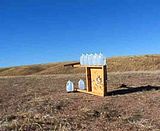
The round exploded the first 2 jugs but penetrated clear into the 5th which contained the round, which mushroomed beautifully. It retained for all intents and purposes 100% of it's mass at that velocity.
Shot 2 and subsequent were the .460 rowland.
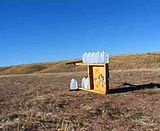
The .460 likewise exploded the 1st 2 jugs, punched through jug 4 and then left for parts unknown. The 5th jug showed marks, but unknown if they were made by the bullet exiting or just plastic on plastic. Regardless the round did not penetrate the 5th jug and I don't know which direction it actually deflected. I arranged what was left of my test medium and repeated the process, during which I managed to recover 2 bullets. Next go round I'll have to take a lot more than 10 jugs

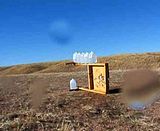

Ok you say, but what if instead of water jugs I'm instead attacked by a rogue pumpkin? By shear chance it happened to my while I was at the range. I believe they were upset that a recent snow killed their actual plants, dooming them from ever ripening into nice orange fruits. I personally try to not kill any wild pumpkin, but sometimes they make the choice for you.
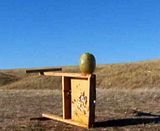
.44 mag 240 gr
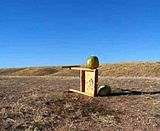
.460
Initially it looked as though the .460 exploded much more significantly on entry than the .44, but that was showing on different pumpkins.
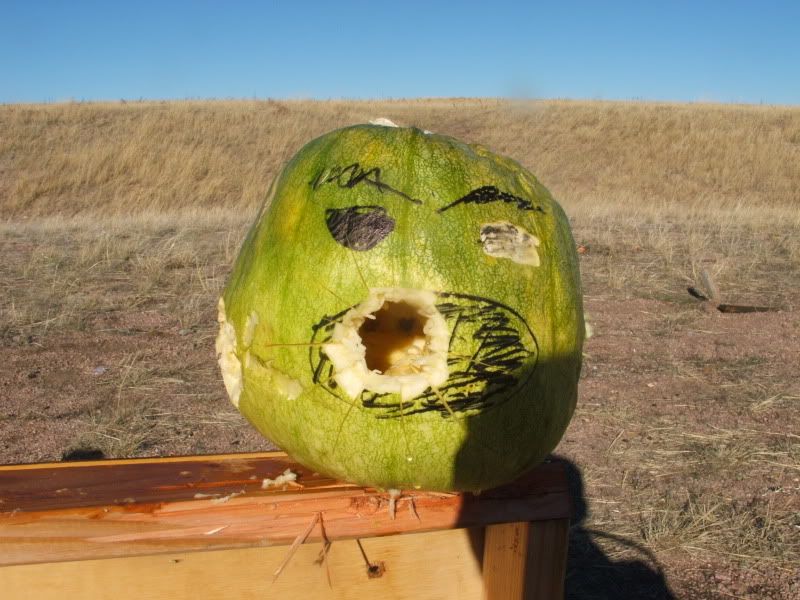
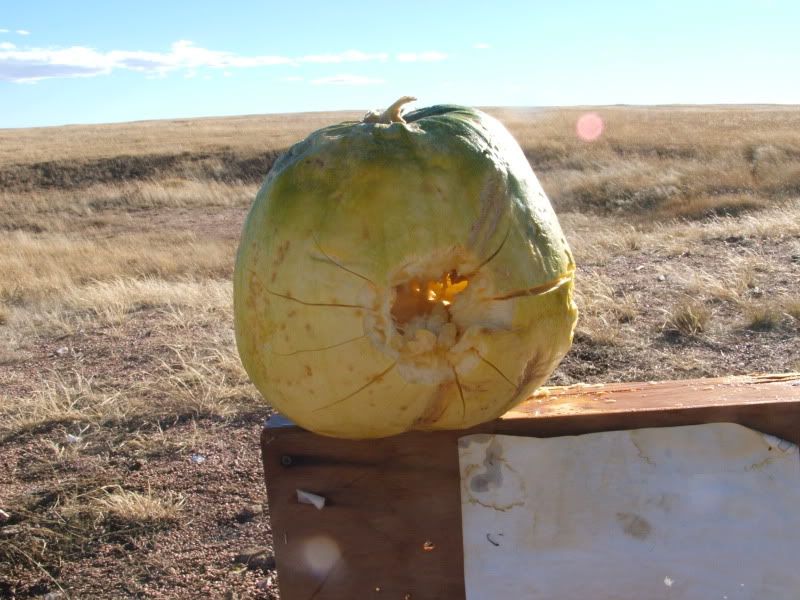
Shooting the same pumpkin with different loads actually showed their performance to be almost indistinguishable from each other. Targets that exploded a round on entry tended to explode both rounds on entry. Targets that showed minimal damage on either side showed the same regardless of round.
As an example .460 left, .44 right.

Exits
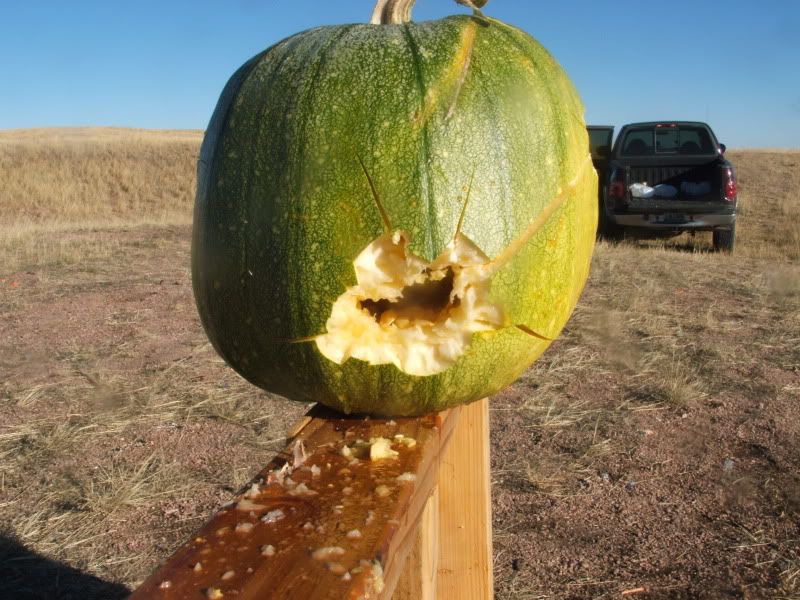
A few more pics and vids can be seen at http://s133.photobucket.com/albums/q45/NdIndy/460%20Rowland/
As I said at the beginning, I believe the velocity of the round plays quite a bit into the bullet performance as does the bullet design. As you can see in the pic, the hollowpoint section of the Winchester is pretty darn minimal, while the opening of the XTP is a substantial portion of it's initial diameter.
![url]](http://[url=http://i133.photobucket.com/albums/q45/NdIndy/460%20Rowland/DSCF3522.jpg t=_blank]http://i133.photobucket.com/albums/q45/NdIndy/460%20Rowland/DSCF3522.jpg[/url])
I will be testing in the future to see if equal velocity gives equal performance in final mass etc. I believe that slowing the 460 down will deliver similar numbers at the detriment of what the higher velocity should be delivering to the target. But with the what I recovered today: (feel free to correct my math)
44 mag winchester bulk
Initial diameter .43
Final diameter .64
Total change 149%
Initial mass 239 gr
Final mass 238.5
Total retained weight 99.7%
.460 Rowland Hornady XTP
Initial diameter .45
Final diameter .76
Total Change 170%
Initial Mass 229gr
Final Mass 176
Total retained weight 79%
In summary, as untold thousands of people go into the woods every year both hunting and feeling safe with a .44mag as a backup with factory loads that are eclipsed by my light handloads, the same people should be even more so with this particular round. Future testing will involve the actual amount of energy delivered in X amount of time, and much more shooting of water jugs. Because it was fun even though at range I was sprayed with both water (not so bad) and pumpkin guts (kind of gross).
The end result, no matter what, it's fun to shoot stuff!

This review is in regard to the round itself, not the conversion which I am still tweaking for reliabilities sake. I've spent some time with the round and plan on quite a bit more time in the future, it's been a fun go round so far.
The intent of the 460 Rowland is to duplicate and/or exceed a .44 magnum 240 grain load in a 1911 sized action. I latched on to the idea based on the ease of carry and semi action form of the 1911 coupled with my past experience with the 44 magnum. For the sake of brevity for those that are short of patience, based on my testing so far the ULTIMATE hunting round between the 44 mag and the 460 rowland is going to be the... well it's the 44 mag in a revolver obviously. The ability to scale the loads up to 300+ grains in a very reliable platform can not be beat in overall hunting situations. However for 90% of shooters who go in the woods every year with factory 240gr .44 mag as a safety backup and don't feel under gunned, you likewise will not feel under gunned with the 460. In contrast the ability to put 7+ rounds of high energy into a target in very quick succession is a very nice bonus compared to the amount of time required to do the same with a revolver.
The conversion itself takes roughly 5 minutes with a complete kit from Clark's custom guns. Once converted a standard 1911 becomes significantly more potent than the .45 ACP or any of it's upscale rounds allows. And it's almost a total sweetheart to shoot. But enough of that, on to the math.
Today I took both my Springfield GI converted to .460 Rowland and my Ruger Super-blackhawk in .44 magnum to the range. This will not be a pure apples to apples comparison as I am using 2 completely different bullets and completely different velocities. But it's the rounds I have on hand so it's the rounds I'm comparing.
.44 Magnum loaded with Winchester bulk 240gr, estimated velocity 800FPS.
.460 Rowland loaded with Hornady XTP 230gr, estimated velocity 1270 fps.
In future testing I will attempt to create an actual duplicate (on paper) load for the 2. As both are pistol bullets changes in velocity will affect bullet performances drastically.
I began with the .44 mag load, by placing 5 gallon jugs of water in contact with each other and firing a single round from approximately 20 yards. I chose water as a medium as it tends to be incredibly destructive on bullets.
I apologize for the photography, using an old camera and windy as a mofo today.
CLICK PICS FOR THE VIDEO!

The round exploded the first 2 jugs but penetrated clear into the 5th which contained the round, which mushroomed beautifully. It retained for all intents and purposes 100% of it's mass at that velocity.
Shot 2 and subsequent were the .460 rowland.

The .460 likewise exploded the 1st 2 jugs, punched through jug 4 and then left for parts unknown. The 5th jug showed marks, but unknown if they were made by the bullet exiting or just plastic on plastic. Regardless the round did not penetrate the 5th jug and I don't know which direction it actually deflected. I arranged what was left of my test medium and repeated the process, during which I managed to recover 2 bullets. Next go round I'll have to take a lot more than 10 jugs



Ok you say, but what if instead of water jugs I'm instead attacked by a rogue pumpkin? By shear chance it happened to my while I was at the range. I believe they were upset that a recent snow killed their actual plants, dooming them from ever ripening into nice orange fruits. I personally try to not kill any wild pumpkin, but sometimes they make the choice for you.

.44 mag 240 gr

.460
Initially it looked as though the .460 exploded much more significantly on entry than the .44, but that was showing on different pumpkins.


Shooting the same pumpkin with different loads actually showed their performance to be almost indistinguishable from each other. Targets that exploded a round on entry tended to explode both rounds on entry. Targets that showed minimal damage on either side showed the same regardless of round.
As an example .460 left, .44 right.

Exits

A few more pics and vids can be seen at http://s133.photobucket.com/albums/q45/NdIndy/460%20Rowland/
As I said at the beginning, I believe the velocity of the round plays quite a bit into the bullet performance as does the bullet design. As you can see in the pic, the hollowpoint section of the Winchester is pretty darn minimal, while the opening of the XTP is a substantial portion of it's initial diameter.
![url]](http://[url=http://i133.photobucket.com/albums/q45/NdIndy/460%20Rowland/DSCF3522.jpg t=_blank]http://i133.photobucket.com/albums/q45/NdIndy/460%20Rowland/DSCF3522.jpg[/url])
I will be testing in the future to see if equal velocity gives equal performance in final mass etc. I believe that slowing the 460 down will deliver similar numbers at the detriment of what the higher velocity should be delivering to the target. But with the what I recovered today: (feel free to correct my math)
44 mag winchester bulk
Initial diameter .43
Final diameter .64
Total change 149%
Initial mass 239 gr
Final mass 238.5
Total retained weight 99.7%
.460 Rowland Hornady XTP
Initial diameter .45
Final diameter .76
Total Change 170%
Initial Mass 229gr
Final Mass 176
Total retained weight 79%
In summary, as untold thousands of people go into the woods every year both hunting and feeling safe with a .44mag as a backup with factory loads that are eclipsed by my light handloads, the same people should be even more so with this particular round. Future testing will involve the actual amount of energy delivered in X amount of time, and much more shooting of water jugs. Because it was fun even though at range I was sprayed with both water (not so bad) and pumpkin guts (kind of gross).
The end result, no matter what, it's fun to shoot stuff!


